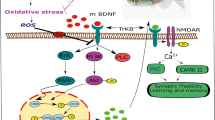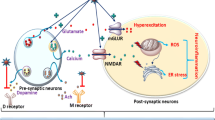Abstract
The goal of this study was designed to evaluate the possible protective effects of Nigella sativa (NS) on the neuronal injury in the frontal cortex and brain stem after chronic toluene exposure in rats. The rats were randomly alotted into one of three experimental groups: A (control), B (toluene treated) and C (toluene treated with NS); each group contain 10 animals. Control group received 1 ml serum physiologic and toluene treatment was performed by inhalation of 3,000 ppm toluene, in a 8 h/day and 6 day/week order for 12 weeks. The rats in NS treated group was given NS (in a dose of 400 mg/kg body weight) once a day orally by using intra gastric intubation for 12 weeks starting just after toluene exposure. Tissue samples were obtained for histopathological investigation. To date, no histopathological changes of neurodegeneration in the frontal cortex and brain stem after chronic toluene exposure in rats by NS treatment have been reported. In this study, chronic toluene exposure caused severe degenerative changes, shrunken cytoplasma, severely dilated cisternae of endoplasmic reticulum, markedly swollen mitochondria with degenerated cristae and nuclear membrane breakdown with chromatin disorganization in neurons of the frontal cortex and brain stem. The nerve cells showing the pathologic changes were almost absent in the NS-treated rats. We conclude that NS therapy causes morphologic improvement on neurodegeneration in frontal cortex and brain stem after chronic toluene exposure in rats. We believe that further preclinical research into the utility of NS may indicate its usefulness as a potential treatment on neurodegeneration after chronic toluene exposure in rats.



Similar content being viewed by others
References
Bergamaschi E, Smargiassi A, Mutti A, Cavazzini S, Vettori MV, Alinovi R, Franchini I, Mergler D (1997) Peripheral markers of catecholaminergic dysfunction and symptoms of neurotoxicity among styrene-exposed workers. Int Arch Occup Environ Health 69(3):209–214
Benignus VA, Muller KE, Barton CN, Bittikofer JA (1981) Toluene levels in blood and brain of rats during and after respiratory exposure. Toxicol Appl Pharmacol 61(3):326–334
Greenberg MM (1997) The central nervous system and exposure to toluene: a risk characterization. Environ Res 72(1):1–7
Pryor GT, Rebert CS, Howd RA (1987) Hearing loss in rats caused by inhalation of mixed xylenes and styrene. J Appl Toxicol 7:55–61
Crofton KM, Lassiter TL, Rebert CS (1994) Solvent-induced ototoxicity in rats: an atypical selective mid-frequency hearing deficit. Hear Res 80(1):25–30
Campagna D, Stengel B, Mergler D, Limasset JC, Diebold F, Michard D, Huel G (2001) Color vision and occupational toluene exposure. Neurotoxicol Teratol 23(5):473–480
Baelum J (1991) Human solvent exposure: factors influencing the pharmacokinetics and acute toxicity. Pharmacol Toxicol 1:1–36
Ladefoged O, Strange P, Moller A, Lam HR, Ostergaard G, Larsen JJ, Arlien-Soborg P (1991) Irreversible effects in rats of toluene (inhalation) exposure for six months. Pharmacol Toxicol 5:384–390
Hass U, Lund SP, Hougaard KS, Simonsen L (1999) Developmental neurotoxicity after toluene inhalation exposure in rats. Neurotoxicol Teratol 21:349–357
Mattia CJ, Ali SF, Bondy SC (1993) Toluene-induced oxidative stres in several brain regions and other organs. Mol Chem Neuropathol 3:313–328
Burmistrov SO, Arutyunyan AV, Stepanov MG, Oparina TI, Prokopenko VM (2001) Effect of chronic inhalation of toluene and dioxane on activity of free radical processes in rat ovaries and brain. Bull Exp Biol Med 3:832–836
Benignus VA (1981) Neurobehavioral effects of toluene: a review. Neurobehav Toxicol Teratol 3:407–415
Oppenheim RW (1991) Cell death during development of the nervous system. Annu Rev Neurosci 14:453–501
Oppenheim RW (1996) The concept of uptake and retrograde transport of neurotrophic molecules during development: history and present status. Neurochem Res 21:769–777
Clarke PG, Posada A, Primi MP, Castagne V (1998) Neuronal death in the central nervous system during development. Biomed Pharmacother 52:356–362
Zimmermann KC, Bonzon C, Green DR (2001) The machinery of programmed cell death. Pharmacol Ther 92:57–70
Cohen GM (1997) Caspases: the executioners of apoptosis. Biochem J 326:1–16
Henderson Z (1996) Responses of basal forebrain cholinergic neurons to damage in the adult brain. Prog Neurobiol 48:219–254
Hörtnagl H, Hellweg R (1997) Insights into the role of the cholinergic component of the septohippocampal pathway: what have we learned from experimental lesion studies? Brain Res Bull 43:245–255
El-Tahir KE, Ashour MM, Al-Harbi MM (1993) The respiratory effects of the volatile oil of the black seed (Nigella sativa) in guinea-pigs: elucidation of the mechanism(s) of action. Gen Pharmacol 24:1115–1122
El-Kadi A, Kandil O (1987) The black seed (Nigella sativa) and immunity: its effect on human T cell subset. Fed Proc 46:1222
Hanafy MSM, Hatem ME (1991) Studies on the antimicrobial activity of Nigella sativa seed (black cumin). J Ethnopharmacol 34:275–278
Zaoui A, Cherrah Y, Lacaille-Dubois MA, Settaf A, Amarouch H, Hassar M (2000) Diuretic and hypotensive effects of Nigella sativa in the spontaneously hypertensive rat. Therapie 55:379–382
Kanter M, Meral I, Yener Z, Ozbek H, Demir H (2003) Partial regeneration/proliferation of the β-Cells in the islets of Langerhans by Nigella sativa L in streptozocin-induced diabetic rats. Tohoku J Exp Med 20:213–219
Kanter M, Coskun O, Korkmaz A, Oter S (2004) Effects of Nigella sativa on oxidative stress and β-Cell damage in streptozocin-induced diabetic rats. Anat Rec 279:685–691
Kanter M, Coskun O, Budancamanak M (2005) Hepatoprotective effects of Nigella sativa L and Urtica dioica L on lipid peroxidation, antioxidant enzyme systems and liver enzymes in carbon tetrachloride-treated rats. World J Gastroenterol 11(42):6684–6688
Kanter M, Demir H, Karakaya C, Ozbek H (2005) Gastroprotective activity of Nigella sativa L oil and its constituent, thymoquinone against acute alcohol-induced gastric mucosal injury in rats. World J Gastroenterol 11(42):6662–6666
Kanter M, Coskun O, Uysal H (2006) The antioxidative and antihistaminic effect of Nigella sativa and its major constituent, thymoquinone on ethanol-induced gastric mucosal damage. Arch Toxicol 80(4):217–224
Kanter M, Coskun O, Kalayci M, Buyukbas S, Cagavi F (2006) Neuroprotective effects of Nigella sativa on experimental spinal cord injury in rats. Hum Exp Toxicol 25(3):127–133
Fararh KM, Atoji Y, Shimizu Y, Takewaki T (2002) Isulinotropic properties of Nigella sativa oil in streptozotocin plus nicotinamide diabetic hamster. Res Vet Sci 73:279–282
Hsu SM, Raine L, Fanger H (1981) Use of avidin-biotin-peroxidase complex (ABC) in immunperoxidase techniques: a comparison between ABC and unlabeled antibody (PAP) procedures. J Histochem Cytochem 29:577–580
Balster RL (1998) Neural basis of inhalant abuse. Drug Alcohol Depend 51:207–214
Moser VC, Balster RL (1986) The effects of inhaled toluene, halothane, 1, 1, 1,-trichloroethane, and ethanol on fixed-interval responding in mice. Neurobehav Toxicol Teratol 8(5):525–531
Warren DA, Bowen SE, Jennings WB, Dallas CE, Balster RL (2000) Biphasic effects of 1, 1, 1-trichloroethane on the locomotor activity of mice: relationship to blood and brain solvent concentrations. Toxicol Sci 56(2):365–373
Tegeris JS, Balster RL (1994) A comparison of the acute behavioral effects of alkylbenzenes using a functional observational battery in mice. Fundam Appl Toxicol 22(2):240–250
Echeverria D, Fine L, Langolf G, Schork T, Sampaio C (1991) Acute behavioural comparisons of toluene and ethanol in human subjects. Br J Ind Med 48:750–761
Mattia CJ, Adams JD Jr, Bondy SC (1993) Free radical induction in the brain and liver by products of toluene catabolism. Biochem Pharmacol 46(1):103–110
Zabedah MY, Razak M, Zakiak I, Zuraidah AB (2001) Profile of solvent abusers (glue sniffers) in East Malaysia. Malays J Pathol 23(2):105–109
Gotohda T, Tokunaga I, Kubo S, Morita K, Kitamura O, Eguchi A (2000) Effect of toluene inhalation on astrocytes and neurotrophic factor in rat brain. Forensic Sci Int 11:233–238
Moonen G, Rogister B, Leprince P, Rigo JM, Delree P, Lefebvre PP, Schoenen J (1990) Neuro-glial interactions and neural plasticity. Prog Brain Res 86:63–73
Papadopoulos MC, Koumenis IL, Yuan TY, Giffard RG (1999) Primary cortical glial reaction versus secondary thalamic glial response in the excitotoxically injured young brain: astroglial response and metallothionein expression. Neuroscience 92:827–839
Altenkirch H, Mager J, Stoltenburg G, Helmbrecht J (1977) Toxic polyneuropathies after sniffing a glue thinner. J Neurol 214:137–52
Coskun O, Yuncu M, Kanter M, Buyukbas S (2006) Ebselen protects against oxidative and morphological effects of high concentration chronic toluene exposure on rat sciatic nerves. Eur J Gen Med 3(2):64–72
Saavedra H, Palestini M, De Marinis A (1996) Neuronal changes induced by chronic toluene exposure in the cat. Arch Ital Biol 134(3):217–225
Korbo L, Ladefoged O, Lam HR, Ostergaard G, West MJ, Arlien- Soborg P (1996) Neuronal loss in hippocampus in rats exposed to toluene. Neurotoxicology 17:359–366
Baydas G, Reiter RJ, Nedzvetskii VS, Yasar A, Tuzcu M, Ozveren F, Canatan H (2003) Melatonin protects the central nervous system of rats against toluene-containing thinner intoxication by reducing reactive gliosis. Toxicol Lett 137(3):169–174
Chen ST, Chuang JI, Hong MH, Li EIC (2002) Melatonin attenuates MPP+-induced neurodegeneration and glutathione impairment in the nigrostriatal dopaminergic pathway. J Pineal Res 32:262–269
Shen YX, Xu SY, Wei W, Sun XX, Liu LH, Yang J, Dong C (2002) The protective effects of melatonin from oxidative damage induced by amyloid beta-peptide 25–35 in middle aged rats. J Pineal Res 32:85–89
Cuzzocrea S, Reiter RJ (2001) Pharmacological action of melatonin in shock, inflammation and ischemia/reperfusion injury. Eur J Pharmacol 426:1–10
Kanter M (2007) Nigella sativa and derived thymoquinone prevents hippocampal neurodegeneration after chronic toluene exposure in rats. Neurochem Res 33(3):579–588
Yuan J, Yankner BA (2000) Apoptosis in the nervous system. Nature 407:802–809
Oltvai ZN, Milliman CL, Korsmeyer SJ (1993) Bcl–2 heterodimerizes in vivo with a conserved homolog, Bax, that accelerates programmed cell death. Cell 74:609–619
Dalgaard M, Hossaini A, Hougaard KS, Hass U, Ladefoged O (2001) Developmental toxicity of toluene in male rats: effects on semen quality, testes morphology, and apoptotic neurodegeneration. Arch Toxicol 75:103–109
Ladefoged O, Hougaard KS, Hass U, Sørensen IK, Lund SP (2004) Gitte winkel svendsen and Henrik rye lam, effects of combined prenatal stress and toluene exposure on apoptotic neurodegeneration in cerebellum and hippocampus of rats. Basic Clin Pharmacol Toxicol 94:169–176
Wen X, Huang Y, Wang J (2006) Erythropoietin preconditioning on hippocampus neuronal apoptosis following status epilepticus induced by Li-pilocarpine in rats through anti-caspase-3 expression. Neurol India 54(1):58–63
Author information
Authors and Affiliations
Corresponding author
Rights and permissions
About this article
Cite this article
Kanter, M. Protective Effects of Nigella sativa on the Neuronal Injury in Frontal Cortex and Brain Stem After Chronic Toluene Exposure. Neurochem Res 33, 2241–2249 (2008). https://doi.org/10.1007/s11064-008-9702-0
Received:
Accepted:
Published:
Issue Date:
DOI: https://doi.org/10.1007/s11064-008-9702-0




